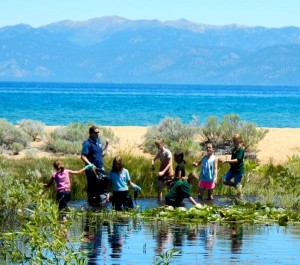Students help environment, learn about yesteryear Tahoe
By Kathryn Reed
CAMP RICHARDSON – Ridding the swales between Tallac and Taylor creeks of invasive species could help reverse the decline of native fish species so in future years third- and fourth-graders might be able to see what the Washoe were accustomed to harvesting from Lake Tahoe.
Back in the day when Washoe summered at the lake and wintered in the Carson Valley, there was a two-week period when they could wade knee-deep into the lake and come out with a basket full of fish.
“There was a seasonal abundance that Lake Tahoe would provide,” Joy Barney, conservation education coordinator with the U.S. Forest Service, explained.

Fifth-graders from the magnet school on June 12 pull milfoil from the swale at Baldwin Beach. Photos/Kathryn Reed
Part of what fourth-graders were learning Tuesday is the historic food web and then comparing it to today.
Speckled dace, tui chub, Lahontan, redsides, Tahoe sucker – while all these fish still exist in Lake Tahoe, their numbers are dwindling because of invasive species.
Meandering through the various old estates that are now owned by the Forest Service, the children are broken into groups to be taught Trees are Terrific, Ways of the Washoe (which has been approved by the tribe) and Founding Families.
For many of the youngsters, this is their first trip to this part of the South Shore. The same could be said for some of the parent chaperones.
Valhalla to Baldwin Beach became an outdoor classroom on June 12 for third-, fourth- and fifth-graders from the environmental magnet school. Third- and fourth-graders in Lake Tahoe Unified and Incline have been spending time at the Tallac Historic Site learning outside the classroom — but using curriculum that meets state requirements.
“The overall theme of the day for the Children’s Forest program is that people and the environment are and always have been intricately connected,” Barney told Lake Tahoe News.
At Baldwin on this particular day are the fifth-graders from the Meyers school. Looking at this small body of water that sits at the edge of the parking lot it seems like a swamp that rational people would not willingly venture into. The beach separates this unattractive wet area from Lake Tahoe.
While the swale is natural in its formation, what isn’t native is what’s living in it – Eurasian milfoil and bullfrogs.
Students are pulling the milfoil out by hand.
“It feels slimy (in the water), but when it comes out, it feels like a leaf plant,” student Summer Furrer says.
She pulled out about 10 handfuls that went into one of the seven garbage bags her class collected.
Part of the class helped put a large black mat that is something like permeable landscaping cloth at the bottom, center part of the swale. This will essentially smother the milfoil, while allowing for oxygen to get to the macro invertebrates that might be under the covering.
What stopping the photosynthesis process does is one of the educational components of the day.
Forrest McCann is articulate beyond his years – clearly demonstrating some adults are not smarter than a fifth-grader.
Part of Barney’s time in the classroom that preceded the field trip was to talk about interpretive signs – what they are good for, how to write one and how to illustrate one.
McCann’s “Save the Swale” sign is so good that it may become the actual sign the Forest Service posts to educate people who come to the area.
This is one of four swales in the area.
Some students are in waders and booties, some are in shorts. All are getting wet to some degree. The deepest part of this particular swale is 3½ feet. Measuring the swale was part of the job for the day – and one way it became a math lesson.
While the students this day are not dealing with the estimated 500,000 bullfrogs that call this area between Tallac and Taylor creek waterways home, they know it would be better if they literally croaked.
“The bullfrogs are bad because they eat native species and make the water dirty,” McCann said.
Sarah Muskopf, aquatics biologist with the Forest Service, is the mastermind behind this particular project. In her waders, she is in the water with the students to help and educate at the same time.
She explains the three treatments going on – hand pulling, the fabric liner and then the jute, which is a rope-like mat that will not have to be removed.
The learning process will continue in the fall when other students will remove the fabric barrier to see if it worked to get rid of the milfoil.
“Even when the whole swale is treated, it will need to be maintained,” Muskopf explained. “It’s like weeds in a yard, it’s never a done deal.”
ngg_shortcode_0_placeholder (Click on photos to enlarge.)